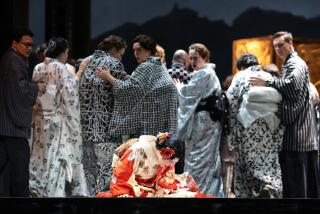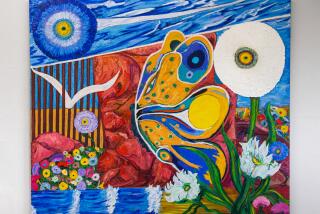A Butterfly House to Beat All Others
- Share via
WESTMINSTER, Colo. — Three-year-old Elizabeth Maller calls herself a shy baby, but that doesn’t stop her from holding a Chilean Rose Hair tarantula. So, what can her mother do?
“Well, if my 3-year-old daughter can do it, I guess I should be able to do it, too,” said Janice Maller.
Mission accomplished for the Butterfly Pavilion and Insect Center, created in July 1995 to help people appreciate--and, yes, even like--insects.
“We want to show people that [insects] are not what horror movies depict them to be,” said curator John Watts.
The world’s first stand-alone butterfly house soon will become the largest. Groundbreaking is planned this winter on a $7.4-million, 38,000-square-foot facility that will include an 80-foot glass pyramid to house butterflies.
It is the brainchild of Michael Weissman, the first curator, who once visited the Day Butterfly Center in Pine Mountain, Ga., and was fascinated with the possibility of butterflies flying free among people.
When people and insects get together, it’s the people who learn.
The center doesn’t defang or devenomize the tarantula, because those are the insect’s last defenses, Watts said. The spider will emit loose hairs from its abdomen first. The hairs produce an itch comparable to a bee sting, Watts said, so visitors are instructed to avoid stroking that area.
Visitors to the “Critter Cabana” also can handle Madagascar hissing cockroaches, so-called because they blow air to scare off predators.
In the conservatory, visitors walk freely around the greenhouse while butterflies flit around. It houses about 1,200 butterflies plus more than 100 tropical and subtropical plants.
Although butterflies act as in the wild, they are lured by certain very human scents, including Lubriderm lotion, and Obsession and Poison colognes.
“One guy had them all over his face because of his shaving lotion,” Watts said.
Esther Forsyth, 9, had a butterfly land on her shoulder and refuse to leave. “I had to push it onto my finger and then onto a leaf,” she said.
Forsyth didn’t really mind because she loves butterflies.
“I had a choice between going to see a movie and coming here. I chose [the pavilion] because I love it so much. It’s cool to look at butterflies, especially the glowy ones,” she said.
There are always new butterflies. Because they live only about two weeks, about 600 pupae are imported from the tropics each week at up to $3.75 apiece.
To the delight of visitors, butterflies are released twice daily after they’ve broken out of their chrysalids.
A third part of the center, the Water’s Edge, was added in February 1998. It houses water invertebrates, including shellfish and sponges, that visitors can touch.
Initial funding for the pavilion came from memberships, private donations, corporate sponsorship, the city of Westminster and a consortium of banks. Admission fees and gift shop sales help fund daily operations.
More to Read
Sign up for The Wild
We’ll help you find the best places to hike, bike and run, as well as the perfect silent spots for meditation and yoga.
You may occasionally receive promotional content from the Los Angeles Times.






